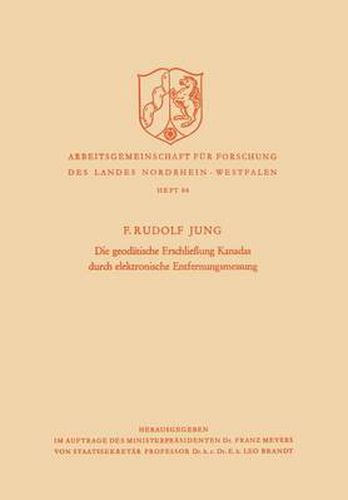Readings Newsletter
Become a Readings Member to make your shopping experience even easier.
Sign in or sign up for free!
You’re not far away from qualifying for FREE standard shipping within Australia
You’ve qualified for FREE standard shipping within Australia
The cart is loading…






This title is printed to order. This book may have been self-published. If so, we cannot guarantee the quality of the content. In the main most books will have gone through the editing process however some may not. We therefore suggest that you be aware of this before ordering this book. If in doubt check either the author or publisher’s details as we are unable to accept any returns unless they are faulty. Please contact us if you have any questions.
Since the end of the war, the electronic methods for measuring distances have made considerable progress and very remarkable new possibilities in the field of surveying techniques have been found. Means originally serving war purposes only have been adapted to civilian and economic use by con- tinued development of methods and equipment. After a survey on the conventional methods of triangulation applied in Germany and the United States and after a brief discussion of modern base measuring by means of the intcrference method according to Vais?la and the geodimeter according to Bergstrand, the Canadian trilateral method is taken as an example to show the specific possibilities the Shoran and the Hiran methods, developed from radar techniques, oHer to-day to a geo- desist for exploring virgin areas. By these methods distances of about 300 to 400 kms can be measured with relatively high accuracy. The longest distances so far covered by one direct Hiran surveying action is known to be 884 kms (see page 55, note 20). Technical problems in the field of surveying arising in connection with the Shoran method are the main subjects, such as the calibration of instru- ment reaction delay, the measuring and determining of the minimum sum and the reduction of the measured lengths to distances on the ground. Fur- thermore, the accuracy achievable with Shoran or the more advanced Hiran- system is discussed in detail, based on the Canadian results obtained during the period 1949 to 1953 and subsequent experience.
$9.00 standard shipping within Australia
FREE standard shipping within Australia for orders over $100.00
Express & International shipping calculated at checkout
This title is printed to order. This book may have been self-published. If so, we cannot guarantee the quality of the content. In the main most books will have gone through the editing process however some may not. We therefore suggest that you be aware of this before ordering this book. If in doubt check either the author or publisher’s details as we are unable to accept any returns unless they are faulty. Please contact us if you have any questions.
Since the end of the war, the electronic methods for measuring distances have made considerable progress and very remarkable new possibilities in the field of surveying techniques have been found. Means originally serving war purposes only have been adapted to civilian and economic use by con- tinued development of methods and equipment. After a survey on the conventional methods of triangulation applied in Germany and the United States and after a brief discussion of modern base measuring by means of the intcrference method according to Vais?la and the geodimeter according to Bergstrand, the Canadian trilateral method is taken as an example to show the specific possibilities the Shoran and the Hiran methods, developed from radar techniques, oHer to-day to a geo- desist for exploring virgin areas. By these methods distances of about 300 to 400 kms can be measured with relatively high accuracy. The longest distances so far covered by one direct Hiran surveying action is known to be 884 kms (see page 55, note 20). Technical problems in the field of surveying arising in connection with the Shoran method are the main subjects, such as the calibration of instru- ment reaction delay, the measuring and determining of the minimum sum and the reduction of the measured lengths to distances on the ground. Fur- thermore, the accuracy achievable with Shoran or the more advanced Hiran- system is discussed in detail, based on the Canadian results obtained during the period 1949 to 1953 and subsequent experience.